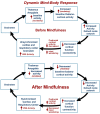Dynamic Change of Awareness during Meditation Techniques: Neural and Physiological Correlates - PubMed (original) (raw)
Dynamic Change of Awareness during Meditation Techniques: Neural and Physiological Correlates
Ravinder Jerath et al. Front Hum Neurosci. 2012.
No abstract available
Figures
Figure 1
The dynamic mind-body response is illustrated by a hypothetical psychophysiological condition before mindfulness meditation, with mind wandering and decreased prefrontal cortex activity, leading to unsynchronized cardiac and respiratory centers (elevated sympathetic nervous system activity) and increased activity of the thalamus and amygdala associated with baseline or increased activity of the Default Mode Network (DMN) and decreased cortical function connectivity. In the final stage and after meditation, there is decreased mind wandering and increased prefrontal cortex activity, leading to synchronized cardiac and respiratory centers (elevated parasympathetic nervous system activity) and decreased activity of the thalamus and amygdala associated with decreased DMN activity and increased cortical function connectivity.
Similar articles
- Neural correlates of nondual awareness in meditation.
Josipovic Z. Josipovic Z. Ann N Y Acad Sci. 2014 Jan;1307:9-18. doi: 10.1111/nyas.12261. Epub 2013 Sep 4. Ann N Y Acad Sci. 2014. PMID: 24033505 Review. - Neural correlates of mindful self-awareness in mindfulness meditators and meditation-naïve subjects revisited.
Lutz J, Brühl AB, Scheerer H, Jäncke L, Herwig U. Lutz J, et al. Biol Psychol. 2016 Sep;119:21-30. doi: 10.1016/j.biopsycho.2016.06.010. Epub 2016 Jul 1. Biol Psychol. 2016. PMID: 27377788 - Reduced mind wandering in experienced meditators and associated EEG correlates.
Brandmeyer T, Delorme A. Brandmeyer T, et al. Exp Brain Res. 2018 Sep;236(9):2519-2528. doi: 10.1007/s00221-016-4811-5. Epub 2016 Nov 4. Exp Brain Res. 2018. PMID: 27815577 - An adaptive workspace hypothesis about the neural correlates of consciousness: insights from neuroscience and meditation studies.
Raffone A, Srinivasan N. Raffone A, et al. Prog Brain Res. 2009;176:161-80. doi: 10.1016/S0079-6123(09)17620-3. Prog Brain Res. 2009. PMID: 19733756 - Studying the experience of meditation through Micro-phenomenology.
Petitmengin C, van Beek M, Bitbol M, Nissou JM, Roepstorff A. Petitmengin C, et al. Curr Opin Psychol. 2019 Aug;28:54-59. doi: 10.1016/j.copsyc.2018.10.009. Epub 2018 Oct 25. Curr Opin Psychol. 2019. PMID: 30502663 Review.
Cited by
- Short-term meditation training alters brain activity and sympathetic responses at rest, but not during meditation.
Rusinova A, Volodina M, Ossadtchi A. Rusinova A, et al. Sci Rep. 2024 May 15;14(1):11138. doi: 10.1038/s41598-024-60932-8. Sci Rep. 2024. PMID: 38750127 Free PMC article. - Hypothesis: Pulmonary Afferent Activity Patterns During Slow, Deep Breathing Contribute to the Neural Induction of Physiological Relaxation.
Noble DJ, Hochman S. Noble DJ, et al. Front Physiol. 2019 Sep 13;10:1176. doi: 10.3389/fphys.2019.01176. eCollection 2019. Front Physiol. 2019. PMID: 31572221 Free PMC article. - The Mechanisms of Mindfulness in the Treatment of Mental Illness and Addiction.
Shonin E, Van Gordon W. Shonin E, et al. Int J Ment Health Addict. 2016;14(5):844-849. doi: 10.1007/s11469-016-9653-7. Epub 2016 May 13. Int J Ment Health Addict. 2016. PMID: 27688740 Free PMC article. - A unified 3D default space consciousness model combining neurological and physiological processes that underlie conscious experience.
Jerath R, Crawford MW, Barnes VA. Jerath R, et al. Front Psychol. 2015 Aug 27;6:1204. doi: 10.3389/fpsyg.2015.01204. eCollection 2015. Front Psychol. 2015. PMID: 26379573 Free PMC article. - Entrainment and coherence in biology.
Srinivasan T. Srinivasan T. Int J Yoga. 2015 Jan;8(1):1-2. doi: 10.4103/0973-6131.146040. Int J Yoga. 2015. PMID: 25558127 Free PMC article. No abstract available.
References
- Alexander C. N., Cranson R. W., Boyer R. W., Orme-Johnson D. (1987). “Transcendental consciousness: a fourth state of consciousness beyond sleep, dreaming, and waking,” in Sleep and Dreams: A Sourcebook, ed. Gackenbach J. (New York: Garland Publishing; ), 282–315
LinkOut - more resources
Full Text Sources
